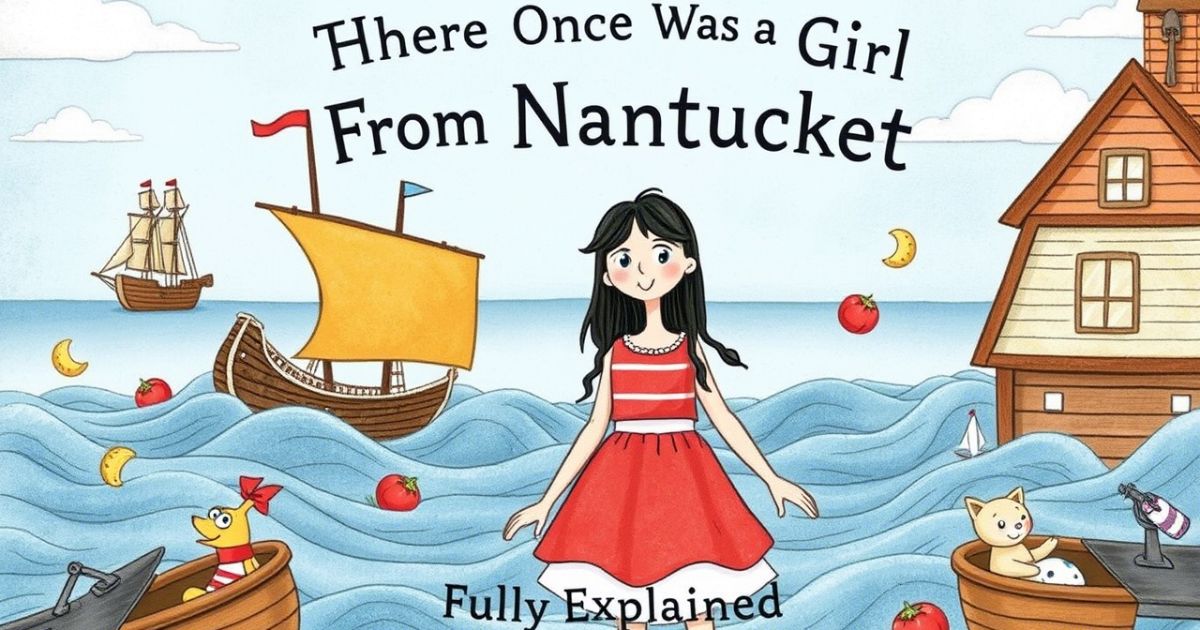“Girl From Nantucket” is a popular, often humorous, limerick that has become a part of American folk tradition. The tale begins with “There once was a girl from Nantucket,” setting the stage for various playful, witty, and sometimes risqué versions of the story. Over the years, the limerick has been shared and altered by many, with each retelling adding a unique twist.
The phrase “Nantucket Girl” often brings to mind a memorable, lighthearted dirty joke. Some versions, like “There was a girl from Nantucket,” have become notorious for their cheeky humor. Many have joked, “I once knew a girl from Nantucket,” referring to the limerick’s central character. While the story has its roots in playful mischief, “Nantucket Girl” continues to be an iconic piece of American humor, shared in a variety of forms, both clean and not-so-clean.
What is the Story of “There Once Was a Girl From Nantucket”?

“There once was a girl from Nantucket” is one of the most famous limericks in the world, with various adaptations and versions circulating over the years. The “Nantucket Girl” limerick is known for its playful tone and catchy rhythm. It often ends with an unexpected or humorous twist, making it a classic example of the limerick genre.
The story itself has been used as a fun vehicle for wordplay, humor, and even dirty jokes. “There once was a girl from Nantucket dirty joke” is a phrase often associated with these limericks, which have become iconic in comedic circles. While some versions can be cheeky or risqué, others maintain a cleaner and more innocent tone. Regardless of the version, the “Nantucket Girl” limerick has become a hallmark of light-hearted poetry that continues to delight audiences.
Whether shared in a casual setting or modified for humorous purposes, the “girl from Nantucket” has cemented its place in the realm of famous limericks. Its enduring popularity shows how a clever, playful rhyme can stand the test of time and remain a beloved piece of comedy.
1. The Content of the Limerick:
The content of the “Nantucket Girl” limerick often revolves around humor, absurdity, and light-hearted misadventures. It typically follows a playful narrative, where the character, whether male or female, is involved in some quirky or amusing situation.
While some versions maintain a clean and innocent tone, others are known for their cheeky or risqué humor, adding a layer of surprise and laughter. The versatility of the limerick allows it to explore various topics, making it adaptable to different audiences and occasions.
A- Clean Version
“There once was a girl from Nantucket,
Who loved to bake pies in a bucket.
She baked them all day,
In a very neat way,
And shared them with folks in a market.”
B- Male Version
“There once was a man from Nantucket,
Who carried a fish in a bucket.
He swam in the sea,
As happy as can be,
Until the fish swam off to a crucket.”
C- Female Version
“There once was a girl from Nantucket,
Who wore a blue dress with a locket.
She danced on the shore,
And smiled evermore,
Her beauty as bright as a rocket.”
2. The Origin of the Limerick:
The origins of “There once was a Nantucket Girl” are somewhat shrouded in mystery, but limericks themselves have roots dating back to the 18th century. The limerick form, known for its humor and rhythm, was popularized in Britain and Ireland before making its way across the world. Nantucket, a picturesque island, was a fitting setting for limericks due to its unique reputation, and this particular rhyme helped cement its place in comedic folklore. The “Nantucket Girl” limerick has since become a favorite in comedic circles, frequently modified to reflect cultural shifts.
The flexibility of limericks means that “there once was a girl from Nantucket” can be adapted to suit any occasion. Whether clean or dirty, the structure allows for creative twists and variations. In the case of the “Nantucket Girl,” the limerick’s humor and catchy nature have made it a staple in both public and private entertainment, influencing generations of humorists.
3. The Structure of the Limerick:
Limericks follow a very specific structure that makes them unique among other types of poetry. “There once was a girl from Nantucket” follows the AABBA rhyme scheme, where the first, second, and fifth lines rhyme, while the third and fourth lines form a shorter, contrasting pair. This simple structure, combined with anapestic meter, gives limericks their characteristic rhythm.
The tight structure is part of what makes “There once was a girl from Nantucket” so adaptable. Though the content may vary, the format remains constant, allowing humorists to create variations that maintain the rhythm and rhyme. Whether the subject is a girl, a man, or something else entirely, the limerick’s five-line pattern ensures a predictable, enjoyable experience for audiences.
In “there once was a Nantucket Girl” and other limericks, the structure allows for a quick punchline that surprises and delights. The rigid rhyme scheme doesn’t stifle creativity; instead, it forces poets to be inventive within constraints. This has led to the enduring success of the limerick form, which continues to entertain with minimal effort.
4. The Enduring Popularity:
The enduring popularity of the “Nantucket Girl” limerick can be attributed to its simplicity, humor, and flexibility. It is easy to remember, making it perfect for casual use in conversation, social media, and even performances. Whether you’re reciting a clean version at a family dinner or sharing a cheekier version among friends, “there once was a girl from Nantucket” is an evergreen piece of comedic poetry that resonates with all ages.
The adaptability of the “Nantucket Girl” limerick ensures that it remains relevant in various social contexts. “I once knew a girl from Nantucket” has become a playful way of starting a joke, often with the expectation of a funny or surprising twist. Whether the limerick is about a girl, a man, or a completely different character, the formula remains engaging.
As a form of humor, limericks are easy to share, and “there once was a Nantucket Girl” has been a favorite for centuries. The ability to modify the rhyme to fit different situations or audiences makes it a go-to for quick humor.
5. The Cultural Impact of the Limerick
The limerick, particularly the famous rhyme about a girl from Nantucket, has deeply embedded itself in popular culture. It has been referenced and adapted across various forms of media, from stand-up comedy to music, books, and even advertisements.
Its presence is especially notable on the internet, where it serves as a foundation for countless memes, YouTube videos, and TikTok challenges. The playful nature of the limerick, combined with its often surprising punchlines, makes it a popular choice for online creators looking to engage with their audience.
Beyond its comedic function, the limerick has occasionally taken on more satirical or even political roles, commenting on social issues in a humorous, digestible way. In essence, the limerick’s versatility has kept it relevant, and it continues to be a medium through which people express humor and creativity.
Related Guide:
I’ll Be Forever Grateful Vs I’ll Forever Be Grateful: Which One?
6. The Evolution of the Limerick
Originally, limericks were not intended to be as controversial or as humorous as the version we know today. Over time, however, limericks began to be seen as a vehicle for humor, particularly in the 19th century when Edward Lear popularized the form. His limericks were whimsical and innocent, often featuring absurd characters and nonsensical adventures.
However, as limericks became more widely known, they evolved to include a broader range of topics, including adult humor, with the “girl from Nantucket” being one of the most well-known examples.
This shift marked a significant turning point where limericks were no longer just lighthearted poems, but also served as a platform for more edgy, risqué humor. In contemporary times, the limerick form continues to evolve, often incorporating modern slang, digital culture, and topical humor, making it relevant to a new generation.
7. The Appeal of Limericks: Why They Work
Limericks are a highly effective form of entertainment because they’re easy to understand and enjoyable to repeat. The fixed, rhythmic structure, five lines, with an AABBA rhyme scheme, gives them a musical quality that sticks in the mind.
This rhythm is part of what makes limericks so fun; it feels almost like a little song or chant, easy to memorize and repeat. The surprise element in the punchline is another reason why they appeal to audiences.
The format sets up an expectation, and the twist in the final line is often what delivers the laughter. Because of their brevity and punch, limericks can pack a lot of humor into a small package, making them perfect for a quick joke or anecdote. This simplicity, combined with humor, is what makes limericks so universally appealing across ages and backgrounds.
8. Variations of the Classic Limerick
The limerick’s flexibility means that the “Nantucket Girl” rhyme has been reworked into a variety of versions. While the original version was relatively innocent and family-friendly, modern takes on the rhyme often introduce edgier or more adult content.
These variations range from whimsical updates that retain the original rhyme and meter to more explicit versions that push the boundaries of humor. Some versions shift the setting from Nantucket to other places, while others alter the characters, introducing new personalities and adventures.
The common thread between all of them is the use of clever wordplay and surprising twists in the final line. This fluidity has allowed the limerick to remain relevant, as different groups continue to adapt it to suit their sense of humor, creating an almost infinite number of variations while keeping the same core structure intact.
9. The Role of Wordplay in Limericks
Wordplay is essential to what makes limericks, particularly the “girl from Nantucket” version, so effective. Limericks rely on clever word choices, often using puns or double meanings that add an extra layer of humor. The concise nature of the form means that each word carries weight, and poets have to make every syllable count.
For example, the use of exaggerated or unexpected language in the final line of a limerick often changes the tone of the entire rhyme, surprising the reader or listener. This element of wordplay also makes limericks highly versatile, as different variations can explore different types of humor.
Whether it’s through a pun, an innuendo, or a misdirection, the power of wordplay ensures that the limerick remains engaging and memorable. As a result, limericks continue to be a go-to tool for comedians and poets who enjoy crafting clever, witty pieces.
10. Popularity in Social Media and Online Platforms
In the age of digital communication, limericks have found a new home on social media platforms, where they continue to thrive. From memes to viral videos, the “Nantucket Girl” rhyme, along with its variations, is often seen on platforms like Twitter, Instagram, and TikTok.
These platforms give users the ability to remix the rhyme, adding their own unique spins or modern references. The easy-to-share nature of limericks makes them perfect for online content, with their quick punchlines and rhyming structure easily capturing the attention of viewers.
The interactive nature of social media allows for a form of crowdsourcing where users can collaborate, creating new limerick versions based on popular trends or events. The limerick’s simplicity, coupled with the viral nature of online culture, ensures that this form of humor remains a beloved part of internet folklore.
11. Common Themes in Limericks
Limericks often delve into themes of absurdity, humor, and exaggeration, which are part of their charm. The limerick from Nantucket, for instance, follows a theme of exaggerating a simple narrative to create a humorous or absurd conclusion.
Often, limericks take a simple situation, a character going on an adventure or experiencing an unusual circumstance, and exaggerate it to ludicrous proportions. This use of exaggeration makes limericks highly entertaining, as the outcome of the narrative is often far removed from reality.
Other common themes include mischievous behavior, love, or satire, allowing poets to explore a wide range of emotions and situations through humor. The ability to stretch the boundaries of reality while maintaining a catchy, rhythmic structure is what gives limericks their staying power across generations.
12. The Role of Humor in Limericks
Humor is the driving force behind every limerick. What sets limericks apart from other forms of poetry is their ability to deliver humor in such a compact, efficient format. The use of absurd situations, silly characters, and unexpected twists in the final line make limericks both funny and memorable.
Humor often comes from the element of surprise, the punchline of a limerick typically flips expectations, making the ending unpredictable. The rhythm of the rhyme also plays a role, as it guides the audience toward the punchline with a certain expectation, which is then subverted.
The way limericks manage to pack humor into just a few lines makes them perfect for both lighthearted fun and more complex commentary on social or political issues, depending on the context.
13. Influence on Modern Limericks

The influence of the limerick extends far beyond traditional poetry. Today, contemporary writers, poets, and comedians still draw from the limerick format, incorporating it into their works to create quick, effective humor.
Modern limericks often reflect current trends, using contemporary slang, references, or cultural icons. For instance, they might incorporate digital memes, political satire, or even current events into the traditional five-line format.
Modern limericks can explore deeper themes, addressing societal issues with a humorous lens. The limerick’s impact can also be seen in other forms of creative writing, such as advertising, where its catchy nature makes it ideal for slogans and memorable taglines. The enduring nature of the limerick proves its continued relevance in both traditional and modern literary landscapes.
FAQ’s
What is the origin of the famous limerick?
The famous limerick comes from a playful rhyme that has been told for generations. It’s most known for its connection to the Nantucket Girl.
Why do different versions of the limerick exist?
Over time, people have adapted the story in various ways. Each version of the Girl From Nantucket brings a new twist to the original.
What makes this limerick so iconic?
The limerick’s humorous and sometimes cheeky nature makes it unforgettable. The tale of the Girl From Nantucket has become a staple in American folklore.
Is the limerick suitable for all audiences?
Though many versions are light-hearted, some retellings of the Girl From Nantucket can be cheeky or adult-themed. It’s best to consider your audience first.
How has the limerick impacted culture?
The limerick has been a part of pop culture for years. It continues to be shared, often in jest, because of its playful take on the Girl From Nantucket.
Conclusion
The “Girl From Nantucket” remains one of the most recognizable limericks in American culture. The phrase “There once was a Nantucket Girl” has sparked countless variations, with many versions circulating for their playful humor. Whether it’s “There was a girl from Nantucket” or a cheekier version like “There once was a girl from Nantucket dirty joke,” the story never fails to entertain.
As people continue to adapt and share their own versions, it’s clear that the “Girl From Nantucket” has become a lasting piece of folklore. From lighthearted jokes to more daring retellings, the story of “Nantucket Girl” remains a fun and sometimes naughty staple. After all, “I once knew a girl from Nantucket” is a phrase that captures the imagination and brings a smile to many.

Zion Blaze is a dedicated administrator with 5 years of experience in managing operations, optimizing workflows, and ensuring efficiency. Skilled in leadership, problem-solving, and team coordination.

